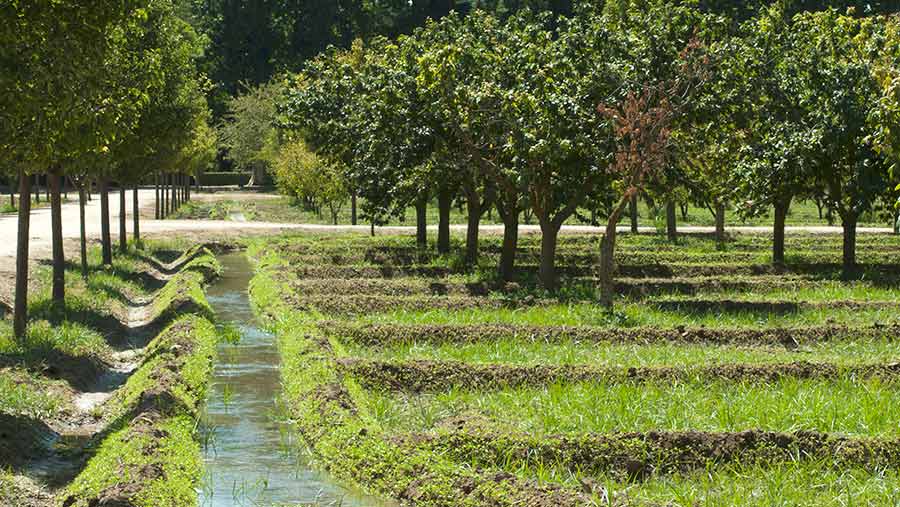Business Clinic: Neighbour’s works causing drainage problems
 © Ingram Image
© Ingram Image Whether it’s a legal, tax, insurance, management or land issue, Farmers Weekly’s experts can help. Here, Richie Rees of solicitor Thrings offers advice on a tricky neighbour issue which is leading to damaged land and trees.
Q. I have eight acres of orchard on heavy land, where drainage is important for tree roots.
The old clay brick pit on my western boundary recently changed ownership and while enlarging it, the new owner’s contractors partially filled it in without my permission. As it is a shared ditch, this amounts to trespass onto my land.
The previous owner assured me he would see the ditch remained untouched. Enlarging the pit required planning permission, granted despite 17 signatures objecting to it. The planning permission also allows all-night fishing.
I am waiting to hear from the planning authority if preservation of the ditch was a condition of the planning permission.
My new neighbour has erected a fence south of the pit which will cause me a nuisance when it comes to maintaining the ditch.
Previously I could walk my boundary along the bottom of the ditch but can no longer do so. What do you suggest I do?
See also: Business Clinic – can executors ignore partnership agreement?
Also, on my eastern boundary the drainage board pumped away the water to the east for 18 years.
There have been many changes to the structure of the drainage board and for reasons of economy it has stopped this pumping, of which I was the only beneficiary.
The chairman of the drainage board advised me to claim for the waterlogged trees through my household insurance.
This I have done – 60 trees at £250 a tree, as the policy says it will pay up to £250 a tree that dies due to vindictive actions. I maintain that choosing to stop pumping from my land was vindictive. How do I get compensation?
A. This scenario presents many legal issues, but it is important to first identify your preferred outcomes so that the appropriate legal solution can be found. I have assumed these four outcomes are desired:
- The restoration of the ditch to its previous condition;
- The removal of the fence so that you can access and maintain the ditch from the south side;
- The recovery of compensation for the waterlogged trees in your orchard; and
- A solution to the drainage situation to avoid future waterlogging. This isn’t expressly stated, but the continued functioning of the orchard appears to be the long-term target.
Ownership
The ownership of the ditch needs to be established. You describe a shared ditch, but it appears to be within the neighbour’s clay brick pit.
It would be worth checking the property deeds or the title at the Land Registry to establish the legal owner(s) of the ditch as this will affect the legal options open to you.
If you are not a legal owner of the ditch, the new neighbour’s failure to obtain your consent to fill it in may be irrelevant in isolation.
However, if the new neighbour’s actions on their own land have caused damage to your land, this could give rise to a legal claim.
Private nuisance
On the basis that the ditch assisted with drainage and the waterlogging of the trees is partly a result of the filling in of the ditch, it may be possible to bring a claim in private nuisance.
This right arises where a person’s actions, even if taken on their own land, unreasonably interfere with your enjoyment or use of your own land.
If proven, a claim for nuisance may allow you to recover damages to compensate you for any actual harm done to your land.
The compensation for the trees in a claim for nuisance would be based on the value of replacing the trees so that you are put into a position as if the damage had never happened.
The value of the trees will not necessarily be the £250 quoted by the insurers, and so a true valuation of your losses would be prudent.
Although issuing proceedings would be a last resort if a negotiated settlement could not be reached, a court may also grant an injunction which would require the neighbour to abate the nuisance.
The neighbour would then be required to remove the offending material and restore the ditch to how it was.
Certain nuisances are statutory by definition, such as accumulations or deposits that are prejudicial to health or a nuisance.
If the above constitutes a statutory nuisance, the local authority has statutory powers to investigate the issue and serve an abatement notice on the person causing the nuisance.
To this end, it would be prudent to contact the local authority so that they can investigate the matter further.
Local authority enforcement
From a practical and economic point of view, awaiting the confirmation from the local planning authority (LPA) as to whether the conditions of the planning permission have been breached before pursuing any claim in nuisance would be prudent.
Again, the LPA has numerous enforcement tools at its disposal if there has been a breach of the condition(s) requiring the landowner to comply with the condition which may result in the ditch being restored in a shorter time than any claim in private nuisance and without the need for you to incur legal costs.
If on the other hand you do own the ditch, the neighbour’s erection of a fence that prevents you from accessing your own property may, on the face of it, amount to a private nuisance.
So, if this scenario cannot be remedied through the LPA taking steps through their planning enforcement or statutory nuisance powers, it may be necessary to resort to civil proceedings and, in particular, pursuing a claim in private nuisance where you can seek remedies as outlined above, namely, abatement of the nuisance and damages.
Do you have a question for the panel?
Outline your legal, tax, finance, insurance or farm management question in no more than 350 words and Farmers Weekly will put it to a member of the panel. Please give as much information as possible.
Send your enquiry to Business Clinic, Farmers Weekly, RBI, Quadrant House, The Quadrant, Sutton, Surrey SM2 5AS.
You can also email your question to fwbusinessclinic@rbi.co.uk.

